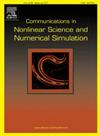Decentralized event-triggered reinforcement learning control for partially unknown nonlinear systems with time-varying states and asymmetric input constraints
IF 3.4
2区 数学
Q1 MATHEMATICS, APPLIED
Communications in Nonlinear Science and Numerical Simulation
Pub Date : 2025-05-17
DOI:10.1016/j.cnsns.2025.108937
引用次数: 0
Abstract
This paper proposes a decentralized event-triggered control scheme based on reinforcement learning to stabilize a class of partially unknown nonlinear mismatched interconnected systems with time-varying state constraints and asymmetric control input constraints. First, a meticulously designed barrier function, which combines traditional and smoothing functions, transforms a constrained interconnected system into an unconstrained one. To address the impact of mismatched interconnections, auxiliary systems are designed for each subsystem. Additionally, non-quadratic utility functions are employed to constrain the inputs of these auxiliary systems. By solving the optimal control scheme for the auxiliary systems, a decentralized control scheme for the integrated mismatched interconnected system is achieved. Unlike traditional actor–critic network structures, the proposed identifier–critic network structure relaxes the constraints on system dynamics and eliminates errors caused by approximating the actor-network. The weight vectors in the critic network are updated using gradient descent and concurrent learning techniques, eliminating the need for traditional persistent excitation conditions. Furthermore, an event-triggered mechanism is introduced to reduce computational load and communication overhead. According to Lyapunov stability theory, it is rigorously proven that all signals of the interconnected nonlinear system are bounded. Finally, simulation examples validate the effectiveness of the proposed control scheme.
时变状态非对称输入约束部分未知非线性系统的分散事件触发强化学习控制
针对一类具有时变状态约束和非对称控制输入约束的部分未知非线性失匹配互联系统,提出了一种基于强化学习的分散事件触发控制方案。首先,精心设计障碍函数,将传统功能与平滑功能相结合,将受约束的互联系统转变为无约束的互联系统。为了解决不匹配互连的影响,每个子系统都设计了辅助系统。此外,采用非二次效用函数来约束这些辅助系统的输入。通过求解辅助系统的最优控制方案,实现了失匹配互联系统的分散控制方案。与传统的行为者-批评网络结构不同,本文提出的标识者-批评网络结构放松了对系统动力学的约束,消除了因逼近行为者网络而产生的误差。使用梯度下降和并发学习技术更新评价网络中的权重向量,消除了对传统持久激励条件的需要。此外,还引入了事件触发机制,以减少计算负载和通信开销。根据李雅普诺夫稳定性理论,严格证明了互联非线性系统的所有信号都是有界的。最后,通过仿真实例验证了所提控制方案的有效性。
本文章由计算机程序翻译,如有差异,请以英文原文为准。
求助全文
约1分钟内获得全文
求助全文
来源期刊

Communications in Nonlinear Science and Numerical Simulation
MATHEMATICS, APPLIED-MATHEMATICS, INTERDISCIPLINARY APPLICATIONS
CiteScore
6.80
自引率
7.70%
发文量
378
审稿时长
78 days
期刊介绍:
The journal publishes original research findings on experimental observation, mathematical modeling, theoretical analysis and numerical simulation, for more accurate description, better prediction or novel application, of nonlinear phenomena in science and engineering. It offers a venue for researchers to make rapid exchange of ideas and techniques in nonlinear science and complexity.
The submission of manuscripts with cross-disciplinary approaches in nonlinear science and complexity is particularly encouraged.
Topics of interest:
Nonlinear differential or delay equations, Lie group analysis and asymptotic methods, Discontinuous systems, Fractals, Fractional calculus and dynamics, Nonlinear effects in quantum mechanics, Nonlinear stochastic processes, Experimental nonlinear science, Time-series and signal analysis, Computational methods and simulations in nonlinear science and engineering, Control of dynamical systems, Synchronization, Lyapunov analysis, High-dimensional chaos and turbulence, Chaos in Hamiltonian systems, Integrable systems and solitons, Collective behavior in many-body systems, Biological physics and networks, Nonlinear mechanical systems, Complex systems and complexity.
No length limitation for contributions is set, but only concisely written manuscripts are published. Brief papers are published on the basis of Rapid Communications. Discussions of previously published papers are welcome.
 求助内容:
求助内容: 应助结果提醒方式:
应助结果提醒方式:


